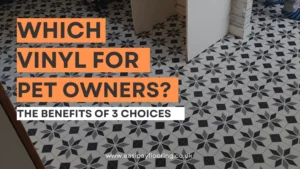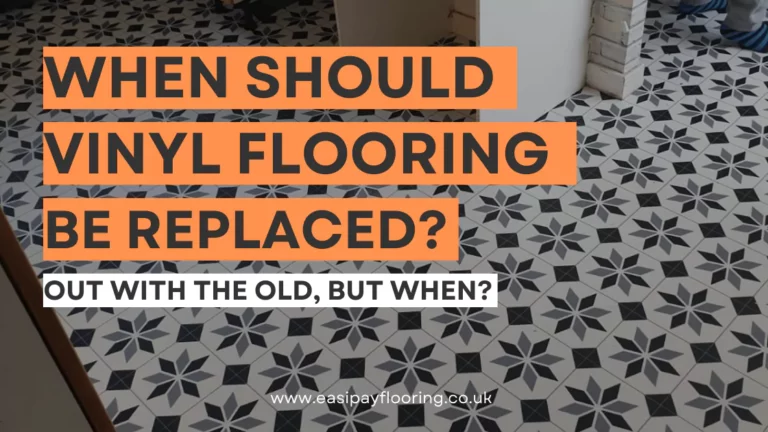
Please Note: We’re currently out of stock of LVT, while we switch supplier, we’ve reduced the cost of SPC flooring to the price of our LVT.

Get In Touch:
03303 332360


Vinyl flooring is known for its durability, cost-effectiveness, and aesthetic versatility, making it a popular choice in many homes and businesses. However, like all materials, it has a lifespan, and there will come a time when it needs replacing. Knowing when to replace your vinyl flooring can save you from enduring unsightly floors and potential structural issues. Here, we explore the signs that indicate it’s time for a new floor and the factors to consider in the decision-making process.
Over time, vinyl flooring can show signs of wear such as scratches, scuffs, and even tears. High-traffic areas are particularly susceptible. When these imperfections become not only visible but also widespread, it’s time to consider replacement.
Vinyl floors can fade or become discoloured due to exposure to sunlight or the use of harsh cleaning products. Significant discoloration can affect the overall look of your room and is a clear sign that your flooring may need updating.
Issues such as lifting edges, bumps, or warping typically occur due to moisture problems or uneven subfloors. Not only does this affect the appearance, but it can also pose a safety risk. When repairs are no longer feasible, replacement is the next step. If you’ve got bubbles in your vinyl flooring you may be able to fix the issue and remove them without replacing the whole floor.
Vinyl flooring, especially if it’s older, can absorb and retain odours, particularly if pet accidents or spillages have penetrated the seams. Persistent unpleasant odours can sometimes only be remedied by replacing the floor.
Flooring styles can change, and what was once trendy may now look dated. Updating your vinyl flooring can refresh your space and increase your home’s aesthetic appeal and value.
If there is water damage or structural issues with the subfloor, replacing the vinyl flooring is often necessary to address these deeper problems effectively.
Read more: Which Vinyl Flooring is Best for Bathrooms
Evaluate the cost of both removal and installation of new flooring. Vinyl flooring comes in various price ranges, and setting a budget can help guide your choice.
Consider your household’s lifestyle. High-traffic homes with pets and children may benefit from more durable, high-quality vinyl options.
Decide whether to hire professionals or undertake a DIY project. Professional installation can ensure the job is done correctly and efficiently, although DIY can be more cost-effective if you have the skills.
Consider environmentally friendly options for both disposal of your old flooring and selection of new materials. Some vinyl products are recyclable, and newer vinyl options are manufactured to be more eco-friendly.
Replacing your vinyl flooring should be considered when signs of wear and tear compromise aesthetics, functionality, or safety. Evaluating the extent of damage, lifestyle factors, and cost will help you make an informed decision. With a range of styles and qualities available, replacing your vinyl flooring can enhance your space both visually and functionally.
On the hunt for new flooring? At Easipay Flooring we offer Carpets, Laminate, Vinyl, SPC and LVT flooring at affordable prices and we even let you break down the cost into weekly, fortnightly or monthly payment plans too, completely interest free! Sound good? Tap the button below to get set up a home visit to see our samples and get your free quote!
Vinyl flooring can last anywhere from 5 to 25 years, depending on the quality of the material and the conditions of use.
Yes, it is possible to install new vinyl flooring over old vinyl, but only if the existing floor is smooth and in good condition.
Signs include warping, buckling, and mould or mildew growth under the flooring.
Check with local recycling programs to see if vinyl flooring is accepted, or consider disposal at a waste management facility.
Luxury vinyl tiles (LVT) and planks (LVP) are known for their durability and are a good choice for high-traffic areas.
Minor issues like small cuts or loose corners can often be repaired, but widespread damage usually makes replacement a more sensible option.
Regular cleaning, using proper cleaning products, avoiding harsh chemicals, and placing protective pads under furniture can help extend the life of vinyl flooring.
Look for vinyl flooring with a thick wear layer and a comprehensive warranty. Higher-quality vinyl can offer enhanced durability and appearance retention.
Older vinyl flooring may contain phthalates and other chemicals that are now restricted. Replacing old floors with new, certified low-VOC vinyl can reduce potential health risks.
Vinyl flooring installed before the 1980s may contain asbestos. It’s essential to have it professionally tested before removal to ensure safe handling and disposal.
Contact Us!